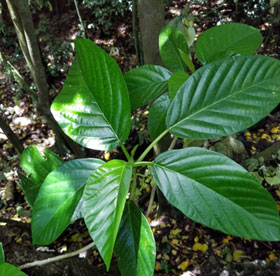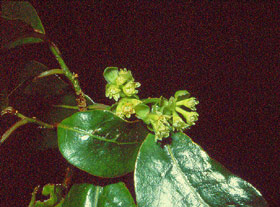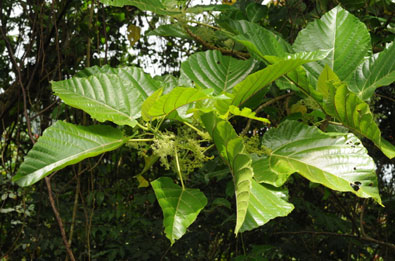Introduction
*Mangeho as a Nettle-tree (Dendrocnide sp.)
The Mageo Banana
The Rarotongan Māngiongio, Acalypha lanciolata
Mangeo in Aotearoa: Litsea calicaria
The relationships of the words in the list of cogates above are either complicated or doubtful. The "nettle" meanings are extensions in a few languages of a Proto-Polynesian word primarily meaning "itchy" or "prickly" in many Polynesian languages. This is clearly the case in Samoan, where the nettle Laportea interrupta, known as ongoongo, is sometimes referred to as vao mageso, i.e. the "prickly weed". In Niuean the application of the cognate word mangiho to the tree Dendrocnide harveyi, and the nettle-like herb Acalpha lanceolata appears to be a similar afterthought, as the primary meaning of the word is "itchy" or "stinging". The Acalpha "nettle" (actually from a very different plant family) is a relatively recent introduction to the Cook Islands (as also to other parts of Polynesia), where one of its names is mangiongio "very itchy", again primarily a description rather than an inherited plant name.
This leaves Samoan mageo, a banana variety, East Futunan māngeo (the nettle tree Dendrocnide latifolia) and Māori mangeo or (more commonly) mangeao (a forest tree without prickles). These are less problematic matches linguistically, but difficult to relate to each other semantically. If the Dendrocnide is ruled out because of the near-match of its name to the other nettle-related plants, that would just leave the Samoan banana and the New Zealand tree. However, in theory at least names generally have a story behind them, raher than being just plucked out of the air. The Dendrocnide causes a great deal of irritation to those who touch its leaves or flowers, but it also has a trunk that can easily be cut through, just like the stem of a banana plant. In this way it is perhaps easier to link the West Futunan and Niuean nettle trees with the Samoan banana than either with the New Zealand tree. However, all these plants are very interesting in themselves, so we can treat them as etymologically linked in Te Māra Reo even if the evidence for that in relation to some of the names is weak.
*Mangeho as a Nettle-tree (Dendrocnide sp.)
 The genus Dendrocnide consists of 37 species of tree-nettles and ranges from China to East Polynesia. D. latifolia (illustrated on the left) ranges from Vanuatu and the Solomon Islands to parts of Micronesia and New Caledonia; D. harveyi is native to Fiji, Niue and Samoa; it once extended to Tahiti but has not been reported from there since the 19th Century. Albert Smith's remarks in his Flora Vitiensis Nova apply to all species of this genus: "The two species of Dendrocnide that occur in Fiji [D. harveyi and D. vitiensis] are greatly respected by all who have come into inadvertent contact with them, as they bear stinging hairs that can cause a very painful irritation." The leaves along with the inflorescence of D. harveyi are notably hazardous. The genus Dendrocnide consists of 37 species of tree-nettles and ranges from China to East Polynesia. D. latifolia (illustrated on the left) ranges from Vanuatu and the Solomon Islands to parts of Micronesia and New Caledonia; D. harveyi is native to Fiji, Niue and Samoa; it once extended to Tahiti but has not been reported from there since the 19th Century. Albert Smith's remarks in his Flora Vitiensis Nova apply to all species of this genus: "The two species of Dendrocnide that occur in Fiji [D. harveyi and D. vitiensis] are greatly respected by all who have come into inadvertent contact with them, as they bear stinging hairs that can cause a very painful irritation." The leaves along with the inflorescence of D. harveyi are notably hazardous.
Dendrocnide harveyi is a large tree, growing to 20 m high. In Samoa it is found most often as a canopy tree growing in disturbed and regenerating forest, although it will be encountered occasionally as a sub-canopy tree in mature secondary and primary forest, from near sea level to 950 m. In Samoa the tree is known as salato, and it is said to have been introduced from Savai'i to Ta'ū (American Samoa) in place of a maiden of the same name who was promised to a chief. Its variable-sized leaves range from 13-40 cm long of varying widths, but rounded at the base and pointed at the tips, with purple veins; their margins are often smooth but sometimes toothed nettle-style. The small green flowers are borne on a panicle up to 15 cm long. Female and male flowers are borne on separate trees. The fruit is a small achene (dry single-seeded fruit) on a fleshy, light-green pedicel (flower stalk).
The stinging hairs are concentrated on the inflorescence and leaves. The wood is too soft to be of much use, but the sap has analgesic properties useful for relieving the pain from stings.
The Mageso Banana
This banana name is listed in Art Whistler's Plants in Samoan Culture and included in the Milner Dictionary, but unfortunately there is no further information in either source, and the name is not included in the results of the 2019 expedition reported on by Gabriel Sachter-Smith and Julie Sardos in their Bananas of Samoa. It has resisted discovery on a web search, but further enquiries are in progress.
The Rarotongan Māngiongio, Acalypha lanciolata
The leaves of Acalypha lanceolata (illustrated in the gallery below) look nettle-like, with serrated edges tapered or pointed at the top while rounded at the base. The leaves can grow to about 8 by 5 cm, but may be much smaller. The herb grows from about 10 cm to 1 m high, and is found in disturbed places like plantations, roadsides and in house lots, It has probably been in Western Polynesia for several centuries (although not deliberately introduced) and perhaps arrived in the Cook Islands more recently. Its origin is uncertain, but probably somewhere in Southeast Asia. It bears spikes of minute unisexual flowers on the same plant -- the upper flowers on each spike are male and the lower ones female. The fruit is a very small capsule, 1-2 cm long, which splits into two single-seeded segments when ripe.
This member of the Euphorbia family, despite its local names in some places, is neither stinging nor a nettle. However it does have a nettle-like apperance, and could well remind some observers of a miniature nettle tree, so the name māngiongio may well echo both possibilities (it should be noted however that the only local name recorded in the Cook Islands Natural History Project database in puapua). Art Whistler reports (Ethnobotany of the Cook Islands, p. 373) that name māngiongio may also refer to the indigo shrub, Indigofera suffriticosa (Fabaceae), which was intoduced into East Polynesia in the 19th century, probably from Hawai'i. That plant was brought to Hawaii in 1836 by an entrepreneur who manufactured dye from it, but it had also been noted there much earlier (Wagner et al., Manual, p.676).
Mangeo in Aotearoa: Litsea calicaris
 The Mangeao (also known as Mangeo, Tangeo and Tangeao), Litsea calicaris, is one of the many plants found mainly north of Latitude 38 degrees South. It is a small tree, reaching as much as 15 m tall, with a trunk growing to anout 80 cm in diameter. It produces abundant, glossy-green leaves usually whitish below, with reddish-brown stalks and midribs. The leaves range from 5 x 3 to 12 x 5 cm in size; they smell rather like soap when crushed. The bark is smooth and dark green in colour, often covered by lichens and becoming flaky as the tree ages. The crown is spreading and rounded in the open, but the tree is more compact and erect in the forest. The tree has delicately fragrant creamy-coloured male and female flowers, borne on separate trees. The flower buds are formed in winter, opening with groups of 4 or 5 small flowers in spring, The fruits are droops up to 2 cm long, held in small green cups from the flower tube. Thry are green to start with, becoming very dark purple when ripe. The tree normally flowers in September or October and the fruit appear in early summer, but may take a full year to ripen. The Mangeao (also known as Mangeo, Tangeo and Tangeao), Litsea calicaris, is one of the many plants found mainly north of Latitude 38 degrees South. It is a small tree, reaching as much as 15 m tall, with a trunk growing to anout 80 cm in diameter. It produces abundant, glossy-green leaves usually whitish below, with reddish-brown stalks and midribs. The leaves range from 5 x 3 to 12 x 5 cm in size; they smell rather like soap when crushed. The bark is smooth and dark green in colour, often covered by lichens and becoming flaky as the tree ages. The crown is spreading and rounded in the open, but the tree is more compact and erect in the forest. The tree has delicately fragrant creamy-coloured male and female flowers, borne on separate trees. The flower buds are formed in winter, opening with groups of 4 or 5 small flowers in spring, The fruits are droops up to 2 cm long, held in small green cups from the flower tube. Thry are green to start with, becoming very dark purple when ripe. The tree normally flowers in September or October and the fruit appear in early summer, but may take a full year to ripen.
 The tree has a strong, durable, and flexible wood, which was one of those used for canoe-building if kauri and totara were not available -- however mainly small canoes were constructed from it originally because although it was light and bouyant, the wood was also so tough that it was difficult to work with stone tools. Later it was used for cooperage and wheel-making, and more recently it has been used in the "Beehive", the building housing key members of the New Zealand parliament, for the ninth floor where the Prime Minister's office is located. The tree has a strong, durable, and flexible wood, which was one of those used for canoe-building if kauri and totara were not available -- however mainly small canoes were constructed from it originally because although it was light and bouyant, the wood was also so tough that it was difficult to work with stone tools. Later it was used for cooperage and wheel-making, and more recently it has been used in the "Beehive", the building housing key members of the New Zealand parliament, for the ninth floor where the Prime Minister's office is located.
The genus to which the Mangeao belongs ranges from Asia to parts of Polynesia, along with Central America and the Southeast United States. There is one endemic species in Samoa (Litsea samoensis, papaono or afoafoa) and another in Tonga (L. mellifera, mamea). The New Zealand species is also endemic.

Dendrocnide harveyi - Mangiho (Niue)
(Waimagu, Samoa. Photo (c) John P, via iNaturalist)
|

Litsea calicaris - Mangeao (Foliage)
(Mt Karioi, Waikato, NZ. Photo: John Sawyer (c) NZPCN) |

Dendrocnide harveyi - Mangiho (Niue)
(Near Nayavutoka, Fiji. Photo: (c) Christian Moliné, via Kew Database)
|

Acalypha lanceolata - Māngiongio (Rarotonga)
(Photo: (c) Gerald McCormack, CINHP) |

Litsea calicaris - Mangeao, Mangeo
(Moerewa, Bay of Islands. Photo: (c) Jeremy Rolfe, NZPCN)
|

Male flowers of Litsea calicaris, - Mangeao, Mangeo
(Greatly enlarged. Photo: (c) Jeremy Rolfe, NZPCN) |
|

